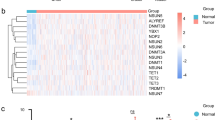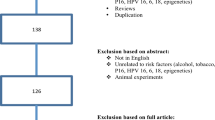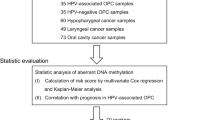Abstract
Head and neck cancer remains a morbid and often fatal disease and at the present time few effective molecular markers have been identified. The purpose of the present work was to identify new molecular markers for head and neck squamous cell carcinoma (HNSCC). We applied methylation-sensitive arbitrarily primed PCR (MS/AP-PCR) to isolate sequences differentially methylated in HNSCC. The most frequently hypermethylated fragment we found maps close to a cytosine guanine dinucleotide (CpG) island on chromosome 9q33.2, and hypermethylation of this CpG island was associated with transcriptional silencing of an alternative transcript of the LHX6 gene. Using combined bisulfite restriction analysis (COBRA), hypermethylation of this fragment was detected in 13 of 14 (92.8%) HNSCC cell lines studied and 21 of 32 (65.6%) primary tumors, whereas little or no methylation was seen in 10 normal oral mucosa samples. We extended this investigation to other cancer cell lines and methylation was found in those derived from colon, breast, leukemia and lung, and methylation was also found in 12/14 primary colon tumors. These findings suggest that differentially methylated (DIME)-6 hypermethylation is a good cancer marker in HNSCC as well as in other kinds of neoplasias and confirm the importance of searching for markers of epigenetic dysregulation in cancer.
This is a preview of subscription content, access via your institution
Access options
Subscribe to this journal
Receive 50 print issues and online access
$259.00 per year
only $5.18 per issue
Buy this article
- Purchase on Springer Link
- Instant access to full article PDF
Prices may be subject to local taxes which are calculated during checkout






Similar content being viewed by others
References
Alves G, Tatro A, Fanning T . (1996). Gene 176: 39–44.
Casiglia J, Woo SB . (2001). Gen Dent 49: 72–82.
Chen RZ, Pettersson U, Beard C, Jackson-Grusby L, Jaenisch R . (1998). Nature 395: 89–93.
Esteller M, Sanchez-Cespedes M, Rosell R, Sidransky D, Baylin SB, Herman JG . (1999). Cancer Res 59: 67–70.
Florl AR, Lower R, Schmitz-Drager BJ, Schulz WA . (1999). Br J Cancer 80: 1312–1321.
Gonzalgo ML, Liang G, Spruck 3rd CH, Zingg JM, Rideout 3rd WM, Jones PA . (1997). Cancer Res 57: 594–599.
Grati FR, Sirchia SM, Garagiola I, Sironi E, Galioto S, Rossella F et al. (2000). Cancer Genet Cytogenet 118: 57–61.
Grigoriou M, Tucker AS, Sharpe PT, Pachnis V . (1998). Development 125: 2063–2074.
International Union Against Cancer (1992). UICC TNM atlas: illustrated guide to the TNM/pTNM classification of malignant tumours. 3rd edn, 2nd revision. Springer-Verlag: Berlin, pp 50–55.
Issa JP . (1999). Crit Rev Oncol Hematol 32: 31–43.
Jones PA, Buckley JD . (1990). Adv Cancer Res 54: 1–23.
Kawai J, Hirotsune S, Hirose K, Fushiki S, Watanabe S, Hayashizaki Y . (1993). Nucleic Acids Res 21: 5604–5608.
Li J, El-Naggar A, Mao L . (2005). Cancer 104: 771–776.
Macluskey M, Ogden GR . (2000). Dent Update 27: 148–152.
Reichart PA . (2001). Clin Oral Investig 5: 207–213.
Shintani S, Nakahara Y, Mihara M, Ueyama Y, Matsumura T . (2001). Oral Oncol 37: 498–504.
Toyota M, Ho C, Ahuja N, Jair KW, Li Q, Ohe-Toyota M et al. (1999). Cancer Res 59: 2307–2312.
Viswanathan M, Tsuchida N, Shanmugam G . (2003). Int J Cancer 105: 41–46.
Wong DT, Todd R, Tsuji T, Donoff RB . (1996). Crit Rev Oral Biol Med 7: 319–328.
Wong IH, Lo YM, Zhang J, Liew CT, Ng MH, Wong N et al. (1999). Cancer Res 59: 71–73.
Xiong Z, Laird PW . (1997). Nucleic Acids Res 25: 2532–2534.
Xu J, Gimenez-Conti IB, Cunningham JE, Collet AM, Luna MA, Lanfranchi HE et al. (1998). Cancer 83: 204–212.
Yoder JA, Walsh CP, Bestor TH . (1997). Trends Genet 13: 335–340.
Acknowledgements
This work was supported by grants from FAPESP (Fundação de Amparo à Pesquisa do Estado de São Paulo, Brazil) grants 99/09368-1 (M.R.H.E.) and 00/12361-8 (E.H.T.) and from the National Institutes of Health (USA) grant R33CA89837 (J-P.J.I.).
Author information
Authors and Affiliations
Corresponding author
Rights and permissions
About this article
Cite this article
Estécio, M., Youssef, E., Rahal, P. et al. LHX6 is a sensitive methylation marker in head and neck carcinomas. Oncogene 25, 5018–5026 (2006). https://doi.org/10.1038/sj.onc.1209509
Received:
Revised:
Accepted:
Published:
Issue Date:
DOI: https://doi.org/10.1038/sj.onc.1209509
Keywords
This article is cited by
-
LHX6 acts as a novel potential tumour suppressor with epigenetic inactivation in lung cancer
Cell Death & Disease (2013)
-
Epigenetic screen of human DNA repair genes identifies aberrant promoter methylation of NEIL1 in head and neck squamous cell carcinoma
Oncogene (2012)
-
Role of DNA methylation in head and neck cancer
Clinical Epigenetics (2011)
-
SDF-1 and CCR5 Genes Polymorphism in Patients with Head and Neck Cancer
Pathology & Oncology Research (2008)
-
Epigenetische Aspekte bei Karzinomen der Kopf-Hals-Region
HNO (2008)



